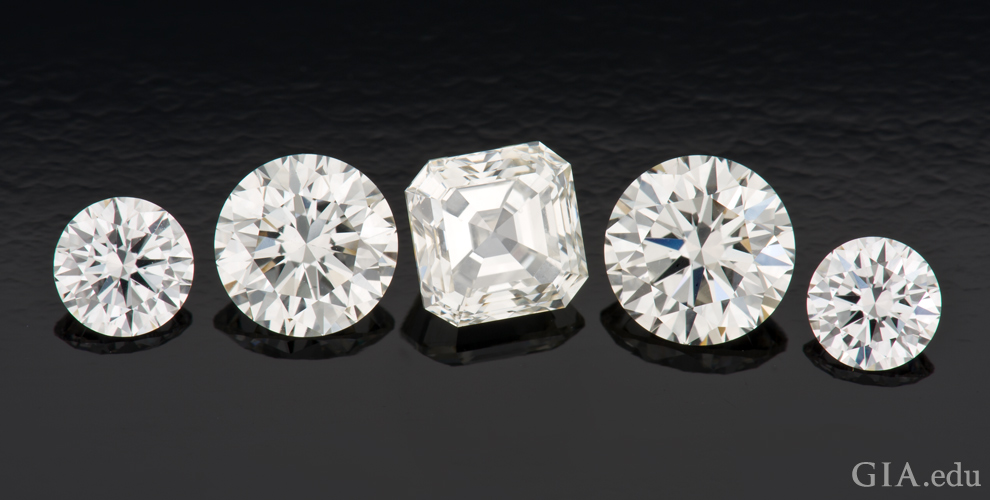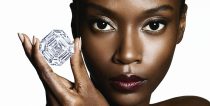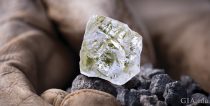Synthetic diamonds are grown in laboratories and have essentially the same chemical composition, crystal structure and physical properties as natural diamonds. They’re real diamonds and not ‘fakes,’ but they are not the same as natural diamonds.
Are synthetic diamonds used in fine jewelry?
Yes, synthetic diamonds now come in as high a quality and nearly as wide a variety of sizes and colors as natural diamonds. Many major retailers offer colorless laboratory-grown diamonds, and Lightbox, part of the De Beers Group, offers a line of colorless, pink and blue lab-grown diamond jewelry, with each diamond marked to identify it as lab-grown.
A brief history of synthetic diamonds
Synthetic diamonds have been produced for industrial purposes since the 1950s and have been used in telecommunications, laser optics and as abrasives and more. It wasn’t until 1970, however, that researchers at General Electric created the first gem-quality synthetic diamonds.
In the mid-1980s, manufacturers began growing commercial quantities of gem-quality synthetic crystals. These diamonds were mostly small in size and were yellowish or brownish in color, but the quality of synthetic diamonds continued to improve over the ensuing decades until present-day, when synthetic diamonds can now rival high-quality natural diamonds in appearance.
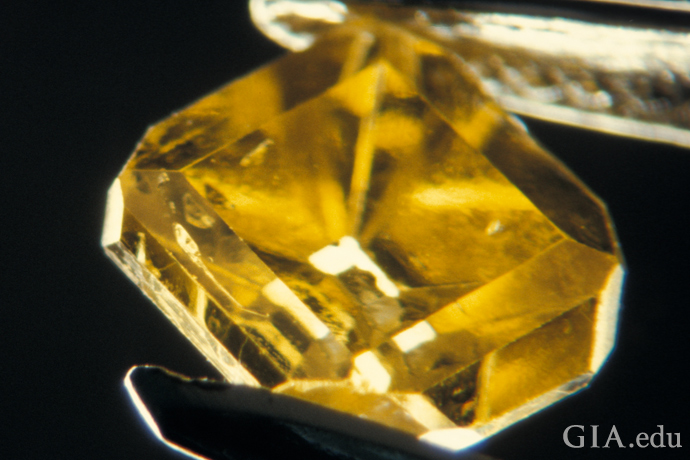
The synthetic diamonds produced by General Electric in the early days of synthetic diamond development were too small and brownish yellow for use in fine jewelry.

Many jewelers allow consumers to choose their own center stone – natural or synthetic – as well as the style of their ring setting. The Alvadora ring by Brilliant Earth can be set with a lab-grown diamond. Courtesy: Brilliant Earth

This ring by designer Scout Mandolin features an emerald-cut center diamond that can either be natural or lab-grown. Courtesy: Scout Mandolin, scoutmandolin.com

The Allure ring by designer Scout Mandolin features an emerald-cut center diamond that can either be natural or lab-grown and is accented with baguette diamonds and round brilliants. Courtesy: Scout Mandolin, scoutmandolin.com
Lab-Grown Diamonds: How are synthetic diamonds made?
While natural diamonds formed millions to billions of years ago beneath the earth’s surface, synthetic diamonds are grown in a matter of days or weeks in modern-day labs. The two major processes are HPHT and CVD.
1. High Pressure, High Temperature (HPHT): With the HPHT method, synthetic diamonds are produced in laboratories through equipment that mimics the high pressure, high temperature conditions that produce natural diamonds in the earth. The result is synthetic diamond crystals with flat bases and octahedral and cube faces. The color of HPHT synthetic diamonds has evolved over the years as technology improved. Synthetic stones submitted to GIA labs have gone from orange-yellow, yellow and yellow-orange to colorless, near-colorless and blue. HPHT and other post-growth treatments of diamonds, whether synthetic or natural, can also turn stones pink, blue and other colors.

The shape of HPHT diamond crystals is distinctly different from that of typical natural diamond crystals. HPHT-grown diamonds have a flat base combined with cube and octahedral faces, while natural diamond crystals tend to be octahedral.

This 8.52-carat (ct) crystal came from the African country of Lesotho. It has the octahedral shape typical of a natural diamond. Photo: Robert Weldon/GIA. Courtesy: Fusion Alternatives
2. Chemical Vapor Deposition (CVD): This newer technique involves breaking down carbon-containing gasses inside a vacuum chamber and having the carbon molecules crystallize onto diamond seed plates. The resulting crystals are tabular in shape and are sometimes edged with graphite. Often brown or yellow in color, these crystals can become near-colorless through subsequent HPHT treatment. “Colorless” CVD diamonds chosen to be polished as gems tend to have slightly higher clarity than their natural counterparts, with most receiving grades in the VVS2 to VS1 range. Most natural diamonds in the D-N color range receive clarity grades in the VS2 to SI1 range.

Uncut CVD diamond crystals are easy to identify due to their unusual shape, but cut CVD diamonds can appear almost identical to their natural counterparts. Some CVD synthetic diamonds display distinctive features, such as particular ultraviolet fluorescence patterns, that indicate they were grown in labs. Their identity can only be conclusively verified, however, by a gemological laboratory with advanced instruments. Photo: Orasa Weldon/GIA
Changing the color of synthetic diamonds through post-grown treatments
Most HPHT diamonds are colorless when grown. But if grown with high amounts of boron, they can turn out deep blue. When grown with nickel, they’ll sometimes be green. When grown with nitrogen, they’ll be an attractive bright yellow. Post-growth treatments of colorless to near-colorless material, such as radiation and annealing, can create pink-to-red or light blue diamonds.
Most CVD synthetic diamonds are initially brown, although near-colorless crystals or those with yellowish coloration can be produced as well. HPHT processes can be used to improve the color of CVD diamonds, such as reducing brownish color so that the diamond is on the near-colorless range of the D-to-Z scale. There is also a multi-step treatment process that can be used to turn brownish lab-grown diamonds into more marketable pink-to-red synthetic diamonds.

Decades ago, most HPHT synthetic diamonds were yellow or brown when grown. Now, most HPHT diamonds are colorless when grown. Copyright: GIA & Tino Hammid
Irradiation and heating are common treatment process that, on their own or combined, can change a synthetic diamond’s color to red, pink or green. People who like fancy colored diamonds but can’t splurge on a yellow, red, pink, blue and green diamonds might turn to synthetic colored diamonds or treated natural diamonds as alternatives.

Synthetic diamonds are available in a variety of colors. This suite of yellow HPHT lab-grown diamond jewelry is accented with colorless natural diamonds; loose red, pink and blue lab-grown diamonds are scattered around it. Photo: Harold & Erica Van Pelt/GIA. Courtesy: (Jewelry) Gemesis Corp.
Do synthetic diamonds look like natural diamonds?
Lab-grown diamonds have nearly the same physical and optical properties as natural diamonds. They are just as hard and are available in nearly as wide a range of quality and colors. Just like natural diamonds, they can be well-cut and have excellent fire, brightness and scintillation, or they can be mediocrely cut; it depends on the shape of the starting material and the skill of the cutter. Pink and blue lab-grown diamonds can sometimes have slightly different coloring than natural pink and blue diamonds. Besides a slight difference in hue, lab-grown pink and blue diamonds are often more saturated in color with less secondary coloring.
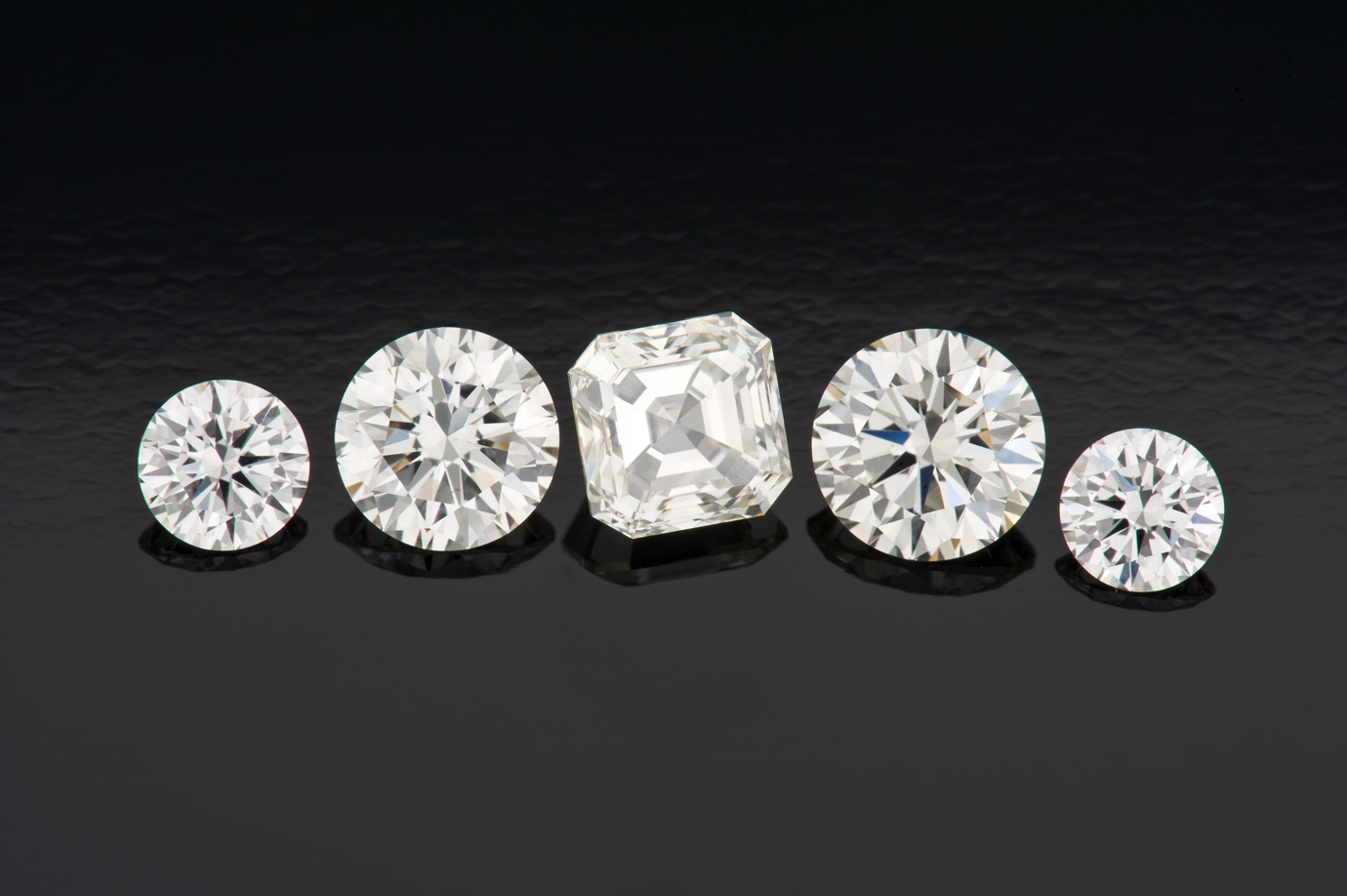
These five CVD synthetic diamonds appear the same to the unaided eye as natural diamonds of comparable quality. Photo: Robert Weldon/GIA
How do you identify a synthetic diamond?
Identifying synthetic diamonds can be a challenge, because the optical and physical properties of synthetic diamonds are nearly identical to those of natural diamonds. Only a gemological lab with advanced testing equipment can authoritatively determine whether a diamond is natural or synthetic.

Metallic inclusions can indicate that a diamond is HPHT synthetic. Metals are often placed as a catalyst along with the diamond seed crystal and graphite into the HPHT reactor to promote diamond growth. The photo above shows two metallic inclusions seen under magnification. Photo: Sally Eaton-Magaña and Troy Ardon
To protect the consumer and prevent confusion, the GIA laboratory issues different reports for natural versus lab-grown diamonds. The GIA Laboratory-Grown Diamond Report looks distinct from the GIA Diamond Grading Report, featuring a gray border instead of a gold border, but the standards used to grade each type of diamond are the same. Each Laboratory-Grown Diamond Report provides a full assessments of the 4Cs of diamond quality and includes a report number that has been laser inscribed onto the girdle of the synthetic diamond. Besides its grading report number, the synthetic diamond is also inscribed with the words “laboratory-grown.”

A GIA Laboratory-Grown Diamond Grading Report.

A GIA Diamond Grading Report for a natural diamond.
Is it a good idea to buy synthetic diamond jewelry?
Synthetic diamonds are just as sparkly and durable as natural diamonds and can be bought at a lower price. But their origin stories are very different. While natural diamonds were created deep in the bowels of the earth millions to billions of years ago, synthetic diamonds are created in laboratories in a matter of days or weeks through HPHT or CVD processes. At the end of the day, whether to purchase a natural, treated or synthetic diamond is a personal choice.

Synthetic diamonds have come a long way from the small, industrial-quality yellow crystals of just a few decades ago. This 10.02-ct colorless, emerald-cut HPHT-grown diamond is one of the largest faceted synthetic diamonds that GIA has examined. Photo: Johnny Leung/GIA
Shopping for an engagement ring? Check out our Guide to Diamond Engagement Ring Terms to help you have a productive conversation with your jeweler.

